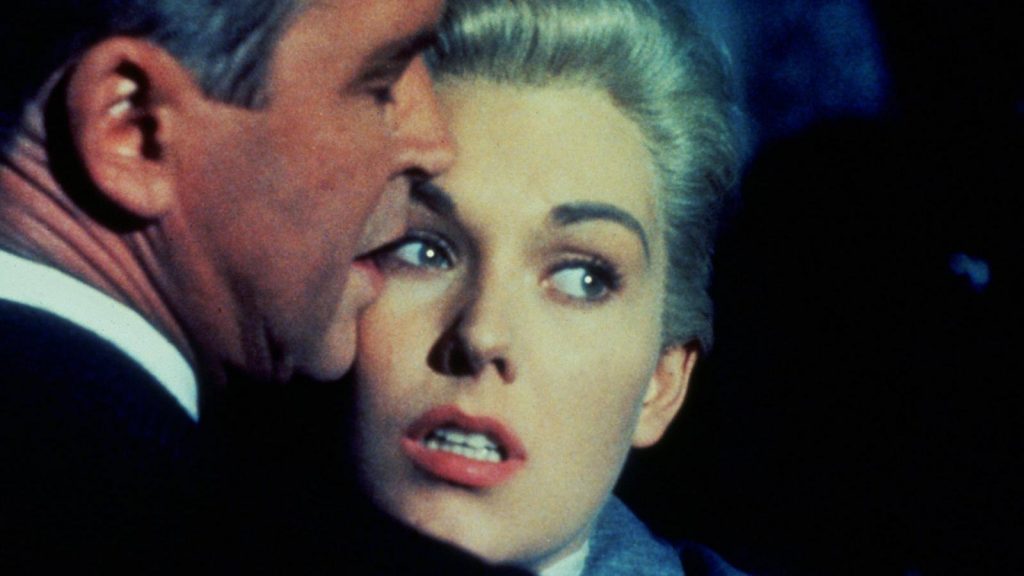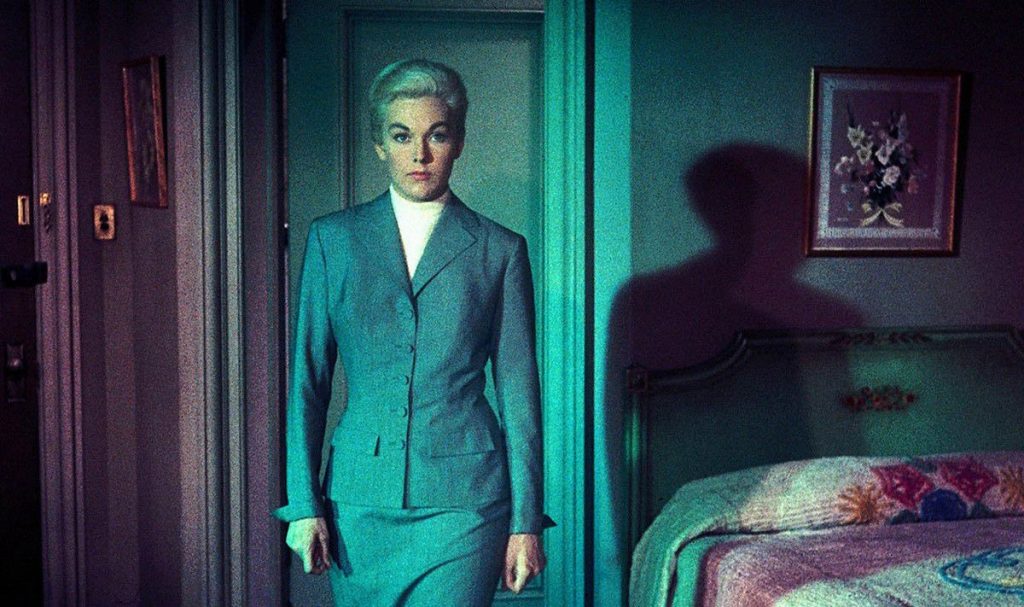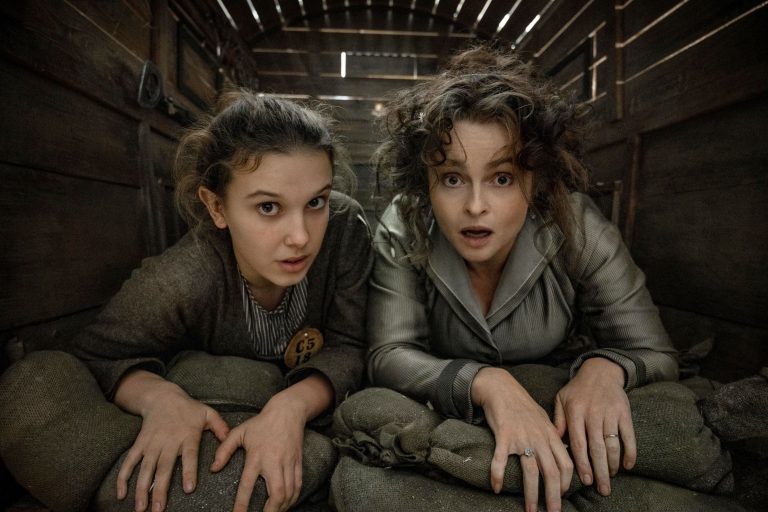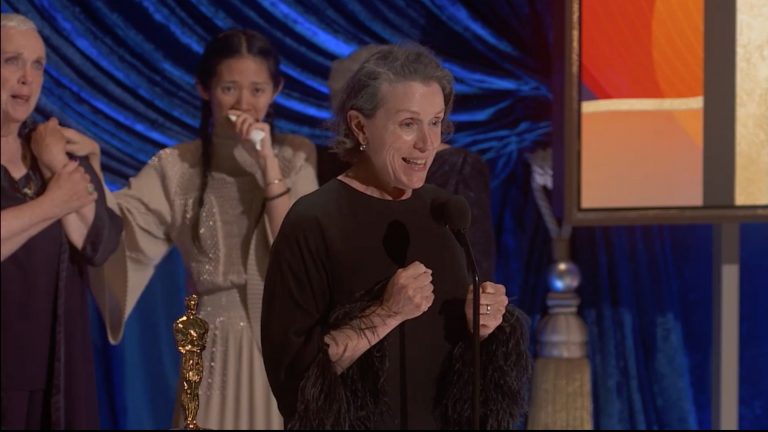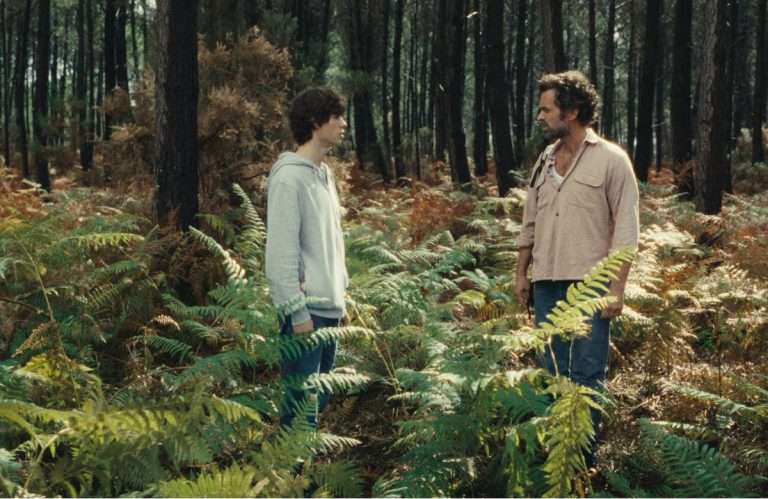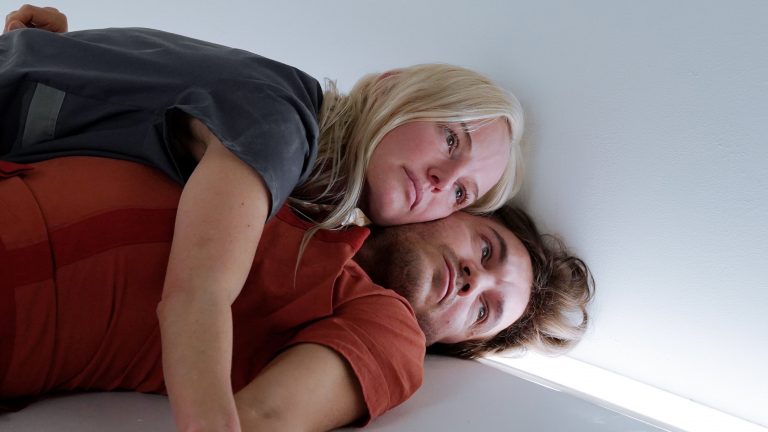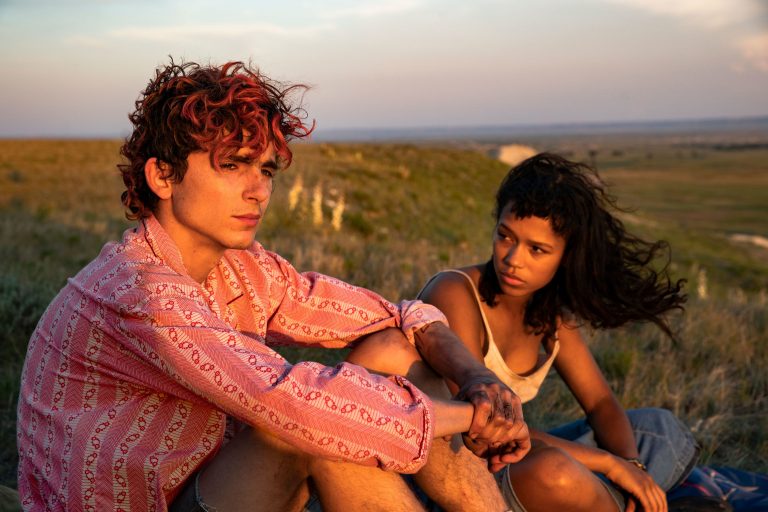Vertigo opens in perhaps the most perfect way: three men are running across rooftops in San Francisco. The sky is a perfect combination of black and blue – the moon’s light spreading across the screen. We don’t know what time it is – whether the sun’s just gone down or is slowly climbing back up to the sky is unbeknownst to us – but what we do know is the action: two men, a police officer, and a detective, are chasing an unknown man, perhaps a crook or murderer. At the end of the action, the rooftop jumps and the gunfire, the police officer lies dead on the ground in a dingy San Francisco alleyway, the crook has escaped, and the detective is dangling over the alleyway in a complete daze from his fear of heights: the police officer stopped to help him, which lead to him tumbling and falling to his death. John “Scottie” Ferguson, in that moment, is merely getting acquainted with the idea of ghosts haunting him – this is only the beginning.
It quickly becomes clear that even though Scottie has just undergone a truly traumatic and life-changing experience, there still lies complete complexity within the wirings of his psyche. Some time has passed, and he’s retired from the force – a seemingly hushed affair since his reasoning isn’t as heroic or honorable as what’s usually expected. The subsequent scene sees him lounging on a couch in his old ex-fiancé’s house. Midge, the woman, clearly still harbors some feelings for Scottie, who, on initial glance, unknowingly notices any of this, much to Midge’s chagrin. There’s banter, but what exists beyond words is the tension between the two: Midge’s passion and Scottie’s ignorance. It all comes back to him and his problem with heights and his vertigo. Scottie views the diagnosis as a restriction against living, a strike against his manhood – he abruptly decides that he can “kick this” like an addiction; three minutes later, he’s collapsed on the floor being held by Midge after looking out her apartment window.
Scottie only shares one bit of vulnerability with us, the audience, that he acknowledges: he is, above anything else, an incredibly lonely man who, at the midpoint of his life, realizes what he secretly desires more than anything else in the world is companionship. We see this when he’s called into an old friend’s workplace. Gavin, the friend, says to Scottie that he needs him to merely observe his wife, Madeleine, who is beginning to think she’s becoming an old ancestor: Carlotta Valdes, who died by suicide. Scottie, rather reluctantly, decides to take on the job. After following her one day, Scottie begins to act differently, almost as if a dying flower was given some water and it rose back up. Alfred Hitchcock is laying down the foundations of Vertigo right then and there: the dependency for Scottie to merely see Madeleine is enough for him to feel complete again – or maybe for the first time.
The changing point for Scottie is when he saves Madeleine from her own suicide attempt: she jumps into the bay that lies below the Golden Gate Bridge and he, unquestionably, dives right in to save her. The next scene is in Scottie’s dark apartment: a truly claustrophobic environment. Madeleine wakes up in his bed, completely naked and afraid – he tells her not to alarm herself and explains that he saved her from the bay. It’s important that we see Madeleine speak at this moment here. Prior to this moment of vulnerability in the bed, Madeleine has always been shot in a daze: Scottie’s attraction to her is built around the initial glance of beauty that Madeleine radiates, not necessarily on the person who has the beauty. These moments feel stripped from a dream, or the idea that we can instantly fall in love with someone by looking at them, the initial gaze into their eyes. And Hitchcock even suggests that idea: it’s totally romantic that way.
What we fail to realize, however, is that until this very moment in the bedroom, Scottie and Madeleine have never once locked eyes and felt their hearts raising. The daze, dream-like imagery leading up to this moment is through the perspective of Scottie, who acknowledges that his only regret in his life was his desire for solitude – with this in mind, we are witnessing a man begin to perceive something that wasn’t there, to begin with. The feeling of their moments before the bedroom may feel romantic and perfect, but they lack the key elements that Scottie is manipulating in his own head. What’s more key is that Madeleine first locks eyes with Scottie in his bedroom, under his sheets, completely naked. What is initially seen as a noble act (Scottie carrying a woman, soaked in water, into his room to let her rest and not sleep with damp clothing) is thrown out the window once we realize that Scottie is someone who desires control: in her most vulnerable state possible, Madeleine is already looking up at Scottie, who displays a sense of power that is intentional and frightening.
Hitchcock wants us to get lost in the notion that Scottie is a somewhat decent man with just a bad string of luck. After showing us the moments involving Madeleine and him walking around San Francisco – again, shot in that daze, dream-like imagery that we saw in the beginning – as they get to know each other, Madeleine, consumed by the ghost of her ancestor, commits suicide at Mission San Juan Bautista, the home of Carlotta. Scottie, who already has the guilt of one man’s death on his shoulders, acquires another: it was because of his vertigo, his fear of heights, that he failed to save another soul. Three ghosts now haunt Scottie: the ghost of the policeman, the ghost of Carlotta Valdes (who in all honesty, haunts the entire landscape of San Francisco), and the ghost of the woman who just announced that she’s in love with him, only to slip through his fingers and plummet to her death minutes later. This further adds to the idea that Scottie, a supposed “good” man, is meant to be a man who clings to the ghosts of the past: the ghosts of the dead and the ghosts of his regrets.
There’s one little detail that often gets neglected when talking about Scottie: Midge and more specifically, her story in the film. Before Scottie enters the sanatorium in a completely catatonic state and Madeleine’s death, Midge paints Scottie a painting of her face on a replica of the Portrait of Carlotta, the painting that hangs in the museum that Madeleine would often gaze at before she met Scottie. Scottie responded almost in disgust, before he walks out of her apartment, not knowing that he’d never speak to her again. It’s in that moment do we realize that Scottie’s obliviousness to Midge’s feelings for him isn’t oblivious: he knew from the beginning that she’s loved him and fed off of that energy. Scottie was lonely, yes, but he was never alone: Midge was always there to help him along the way, sacrificing herself in the hopes that Scottie would just take one more look at her and see the beauty he saw in Madeleine.
Her last scene is of her walking down the hallway of the sanatorium right after she drops off Scottie and talks to the doctors. In a way, this is both an empowering moment and a completely tragic moment for Midge’s development as a character. One can see the moment as pivotal to her love for Scottie. Her walk from the room in which Scottie resides can signify her breaking away from Scottie’s nonsense, knowing that in the state that he’s in, it’s the only way she’d be able to completely do it. But with that, it’s incredibly sad: a lonely woman walks down the hallway knowing that the man she has loved for several years will no longer be a part of her life. Midge, in both viewpoints, is quietly acknowledging the control Scottie had on over her: in both viewpoints, Midge leaves the film completely empty. It’s important that her story ends here because this is a film from the perspective of Scottie, who only saw her as a parasite for him to latch onto. When he leaves the sanatorium, he doesn’t call her at all: he walks around the familiar spots of San Francisco that Madeline used to frequent. He looks for a ghost without realizing that he’s acquired another one in Midge.
In his weakest and most vulnerable form, Scottie, by chance, stumbles upon a woman who looks exactly like Madeleine: Judy, a woman from Kansas who moved to California to experience life outside of the Midwest. Scottie’s interactions with Judy are perhaps the most uncomfortable moments in Vertigo and exist solely for us to realize Scottie’s true intentions as a man in this film. He appears like a phantom in the doorframe of Judy’s apartment, a completely pale and gaunt individual who barely fits in the suit he’s wearing; in a weird way, Scottie moves across the landscape of San Francisco as a ghost. Judy quickly realizes that Scottie’s mourning the loss of his love and agrees to go on a date with him – the legendary twist of the film shows us that Judy was “Madeleine” and that Gavin had hired Judy to pretend to be his wife so he could murder her and get away with it; Scottie’s accident early on allowed for everything to fall completely into place and make it a clean getaway. It’s also revealed that Judy genuinely loved Scottie: she just had to play her part accordingly. But falling in love knows no price.
On their dates, there’s no connection between the two. There are no conversations about life and interests: there’s walking and eating and driving. Judy hopes that Scottie will fall in love with her – Scottie begins to notice the lack of passion and strives to amend this. After all, we’ve seen him fall in love, so why wouldn’t he take this into his own hands and manipulate it? Much like his interactions with Midge, Scottie begins to dig his claws into Judy and attempt to change her image: the brown, shoulder-length hair that she had is quickly cut, dyed, and styled in the same way that Madeleine did, and the purple dresses that Judy sports are tossed aside in favor of the blue-gray pantsuit that Madeleine wore, shoes are replaced with a proper shade – Scottie tells Judy that this is happening because it’s for him to get over Madeleine and fall haplessly in love with Judy and tragically, Judy believes this. She’s become blinded by her own love for Scottie to see what’s truly happening: she loses her own sense of identity.
Scottie isn’t in love with Judy and no matter how hard he changes her (and therefore, breaks her down), he will never be in love with her. He can reduce her to putty and manipulate her in any way that she’d let him, he will never be in love with her: he’s in love with an image, an image that haunts him and clutches his heart and no one will ever fill that void. Judy’s painful descent into depression is expertly conveyed: her smile, once Scottie has complete control over her, is incredibly pained, and her eyes are completely lifeless – we’re witnessing a human being on a leash. The final push is when he realizes that his “Madeleine” never existed; it was Judy performing, an image that, quite literally, is a ghost in a costume. Scottie realizes his control exists larger than what he was enforcing: to “get over Madeleine,” he must repeat history. He takes her to Mission San Juan Barista and repeats the past only this time, making it to the top. Judy, however, lies at the bottom, in the same position that Scottie’s Madeleine laid.
The sky in this final moment matches the sky from the beginning: a dark black-blue with the moon dancing in the sky as it shines its light on a clearly shaken Scottie as a nun rings the church’s bell to alert others about Judy’s corpse. The initial moment that changed Scottie’s life has repeated itself in different forms. The policeman’s hand to Scottie caused him to plummet to his death; Scottie’s hand out to Judy caused her to die – it all circles back, but to what? Before Scottie’s accident, he didn’t have a fear of heights and he didn’t have vertigo (or at least he wasn’t aware that he had it) and his only fear was his own loneliness. The film slowly sees him conquer one of these things, loneliness, while the other has total control. But the cycle must repeat – just like how Carlotta’s death has repeated itself in the form of Judy – and although Scottie may have conquered his fear of heights, he’s right back at the beginning. He’s completely alone, deservedly so, with only the ghosts of the deceased to keep him company. He’s always been a reluctant ghost in that way: one foot in the door of reality, one foot in the door of dreams and the depths of Hell. His loneliness is his purgatory, the cycle that will never allow him to escape.

